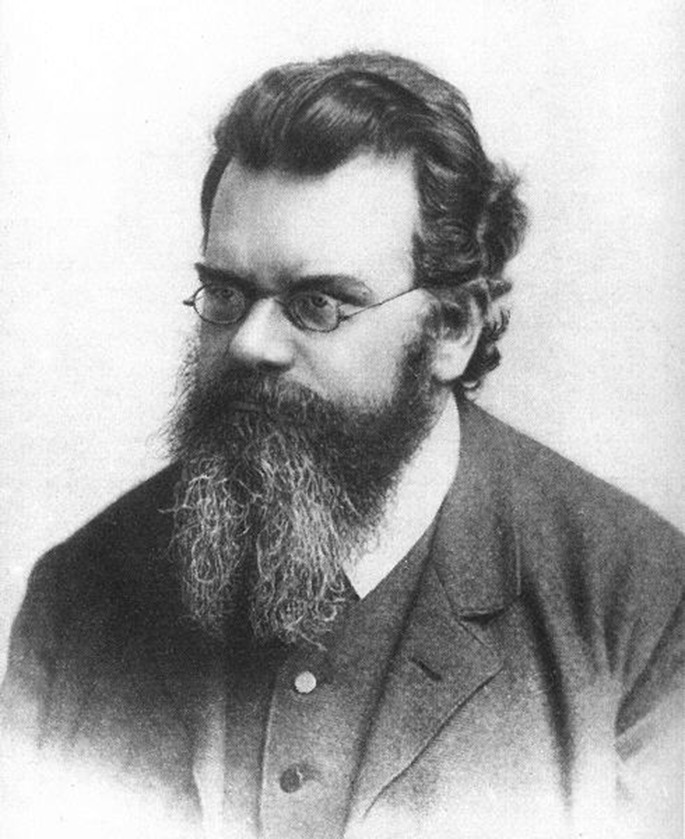Statistical mechanics is a powerful set of mathematical tools that uses probability theory to bridge the enormous gap between the unknowable behaviors of individual atoms and molecules and those of large aggregate systems of them—a volume of gas, for example.

Austrian physicist Ludwig Boltzmann laid the foundation for modern-day ergodic theory. Image courtesy of Goethe University Frankfurt.
Fundamental to statistical mechanics is ergodic theory, which offers a mathematical means to study the long-term average behavior of complex systems, such as the behavior of molecules in a gas or the interactions of vibrating atoms in a crystal. The landmark concepts and methods of ergodic theory continue to play an important role in statistical mechanics, physics, mathematics, and other fields.
Ergodicity was first introduced by the Austrian physicist Ludwig Boltzmann in the 1870s, following on the originator of statistical mechanics, physicist James Clark Maxwell. Boltzmann coined the word ergodic—combining two Greek words: ἔργον (ergon: “work”) and ὁδός (odos: “path” or “way”)—to describe his hypothesis. Although some formulations of his hypothesis were not completely accurate, his ideas seeded an important set of principles and tools.
Boltzmann, working with gases, suggested that the spatial average values giving rise to macroscopic features also arose as averages over time of observable quantities that could be calculated from microscopic states. He realized that this might hold if a system passed through all of the possible microscopic states.
This “strong” form of Boltzmann’s ergodic hypothesis was, however, later seen to be too strong in practice on topological and measure theoretic grounds, says Nándor Simányi, professor of mathematics at the University of Alabama at Birmingham. “Ergodicity was loosely defined. It was an assumption made about the time-evolution of a dynamical system that worked, but the idea that a system goes through every state, that a system goes through every point in the phase space, is impossible; mathematically, it’s nonsense,” he says. “It was, however, satisfactory for a physical understanding of systems.”
The path toward greater theoretical rigor, explains University of Warwick mathematics professor Tom Ward, reached a key milestone in the early 1930s when American mathematician George D. Birkhoff and Austrian-Hungarian (and later, American) mathematician and physicist John von Neumann separately reconsidered and reformulated Boltzmann’s ergodic hypothesis, leading to the pointwise and mean ergodic theories, respectively (see ref. 1).
These results consider a dynamical system—whether an ideal gas or other complex systems—in which some transformation function maps the phase state of the system into its state one unit of time later. “Given a measure-preserving system, a probability space that is acted on by the transformation in a way that models physical conservation laws, what properties might it have?” asks Ward, who is managing editor of the journal Ergodic Theory and Dynamical Systems. The measure on a mathematical space assigns weights to parts of the space.
“Measure theory provides a precise formulation, saying that while a system doesn’t literally pass through every point in the phase space, it may come arbitrarily close to every point,” he explains. “That is, there’s no favored part of the space.” This formulation gives rise to a notion of ergodicity weak enough to hold for many systems and strong enough to have significant consequences.
After decades of relative quiescence, efforts to devise ergodicity models underwent a revival in the 1960s, notably including work by Yakov Sinai, a mathematician now at Princeton University, Simányi says. In 1963, Sinai introduced the idea of dynamical billiards, or “Sinai Billiards,” in which an idealized “hard” particle bounces around inside a square boundary without loss of energy. Inside the square is a circular wall, off of which the particle bounces. He proved that for most initial trajectories of the ball, this system is ergodic—that is, over infinite time, the time average of an observed quantity will equal its average over the space. For any part of the space, the proportion of time the system spends in that region will be proportional to its size.
“If the system spends 3% of the time in a region of its phase space, that region is 3% of the total phase-space volume; they are proportional in size,” Simányi says. It was the first time that someone had rigorously proved that a dynamical system that seemed related to a real physical situation was ergodic.
Ergodic theory continues to have wide impact in statistical physics, number theory, probability theory, functional analysis, and other fields. One prominent example is the Green–Tao theorem. In 2004, Ben Green of the University of Oxford and Terrence Tao of University of California, Los Angeles, building on the work of American-Israeli mathematician Hillel Furstenberg, fused methods from analytic number theory and ergodic theory to prove a “folklore” conjecture dating back to the 1770s that the sequence of prime numbers contains arbitrarily long sequences of numbers in which the difference between consecutive terms is a constant (for example, 3, 5, 7 is such a sequence of length three). Tao went on to earn the 2006 Fields Medal.
References
- 1.Moore CC. Ergodic theorem, ergodic theory, and statistical mechanics. Proc Natl Acad Sci USA. 2015;112:1907–1911. doi: 10.1073/pnas.1421798112. [DOI] [PMC free article] [PubMed] [Google Scholar]


